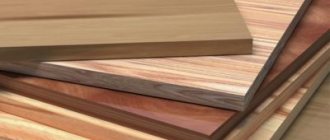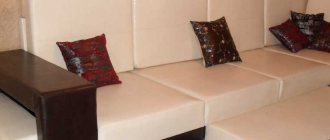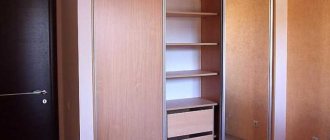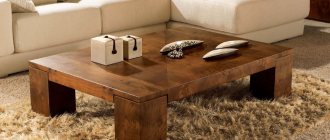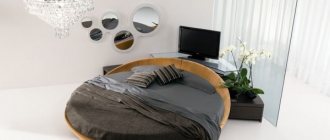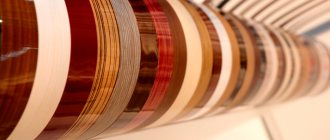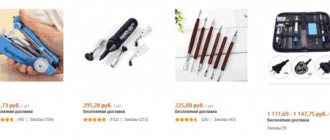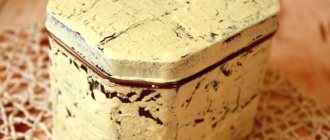Without shelves, which can not only serve as a storage system, but also decorate the interior, it is very difficult to imagine any room. They can have different appearances, all kinds of designs and will allow you to place not only necessary everyday items, but also decorative ones - souvenirs, flowers, flowerpots and much more. This way the room can be made cozy and beautiful. The most commonly used options are wall shelves; they are not difficult to make with your own hands and at the same time you can not only save a lot of money, but also create a truly exclusive and interesting product.
DIY wall shelves
Functionality of wall shelves
Interior design is not an easy job, the goal of which, first of all, is the beautiful and cozy appearance of the room. Everything inside it should be in harmony with each other, not only in color, but also in style, and many, many more factors must also be taken into account. It is very important to choose the right furniture, which will not only be functional, but also suit the interior in all respects.
Wall shelves in the interior
The seemingly most banal interior items – wall shelves – deserve special attention. For an unassuming owner, they may be just ordinary storage systems for a variety of things, but in fact, shelves perform not only this function - they are quite capable of becoming decorative elements in themselves, as well as being a place where other items that decorate the room will be located. That is why it is important to choose a shelf wisely.
Original wall shelf
The functionality of the shelves is as follows:
- ensuring storage of various items;
- the ability to install any decorative element in the plane of the wall;
- decorating the walls of the room;
- acting as a stand for flowers and souvenirs;
- storage of books, etc.
If you wish, you can identify quite a few purposes for using shelves, but these are the main ones. Many shelves can combine several functions at once, and this will depend on the wishes of the owner, as well as on what shape and type of shelf is used.
Shoe shelf made from pallets
Important! When choosing the type of shelf, you should focus on the purpose of its use, the purpose of the room and the general style of the room. Only then will it be possible to buy or make the very product that will fit perfectly into the interior.
How to make a cardboard rack with your own hands
We will conduct a master class on making cardboard shelves with your own hands.
Necessary materials and tools
The only tools you will need are a stationery knife or jigsaw, a glue gun, a simple pencil, a tape measure, and a plastic or wooden ruler.
Cardboard does not contain harmful, toxic or other hazardous substances.
Materials (part optional):
- Cardboard, thick wrapping paper, tracing paper.
- Moment glue, adhesive tape.
- Plastic clips.
- Emery for sanding joints and cuts.
You don’t have to waste time searching for a practical, something you like that will fit perfectly into your interior.
You can speed up the drying of glued structural elements using a regular household hair dryer.
A hairdryer will help dry the cardboard product faster.
Instructions for creating a rack
Let's make the simplest rack from the same type of cardboard boxes. We don't even need a sketch and drawing. No need to take measurements or cut grooves. We already have ready-made storage system elements.
The service life of cardboard furniture will be long if it has not been exposed to moisture and has been correctly processed during creation.
Algorithm of actions:
- Step 1. Take boxes of the same type.
- Step 2. Cut off the lids with scissors.
- Step 3. Connect the boxes to each other. For fastening, you can use glue, tape, or plastic clips.
- Step 4. The lightweight and mobile storage system is ready.
Let's complicate the design a little.
- Step 5. Assemble and fasten smaller drawers. Cut out a rectangular hole in the front of each box.
- Step 6. We get a few more cute drawers for storing shirts, towels and all sorts of small things.
- Step 7. And if we make (or select) boxes in such a way that four pieces fit freely into one compartment of the shelf we previously made, then we will complement the new storage system with drawers. For convenience, they can be signed. It will be easier to find where everything is.
- Step 8. So we made the simplest cardboard bookcase with our own hands.
Some shelves may not be equipped with drawers. We will put larger items here.
Design the finished shelving to your liking.
The ends can be covered with wrapping paper or tracing paper, and then varnish can be applied to all structural elements. Even old newspapers and pages of glossy magazines can become the basis for paintwork. A good decorative option is vinyl film for furniture.
You can decorate cardboard products with your own hands from any materials, it all depends on your wishes and fantasies - there are many options.
Types of shelves
Shelves can be divided into several types depending on the purpose of their use. So, you can select shelves:
- for the corridor, which are used for storing hats and scarves;
- for the kitchen, where there can be various jars and packages of spices;
- for souvenirs;
- flower shelves;
- bookshelves;
- for the office;
- for toys;
- for personal care products, etc.
A corner shelf in the hallway will create its own atmosphere
On a note! There are also specialized shelves designed to store a specific item. For example, a shelf for a musical instrument.
The shelves can also be divided into:
- closed and open . The latter are a plane that has neither side nor back walls. Closed ones are a kind of hanging cabinets, but small in size;
- straight - the simplest shelves having a horizontal plane;
- corner – shelves that are designed for hanging in the corners of rooms;
Beautiful corner shelf
- multi-level - have not one, but several horizontal planes for arranging objects;
- racks , which can be classified as multi-level shelves. But they must have reliable, dense support;
- hanging ones , which have various belts, ropes, etc. as fasteners, can be mounted not on the wall, but on the ceiling, hanging along the wall;
- shelves with a back wall and without walls ;
- round, square, rectangular depending on the shape . Asymmetrical shelves do not have an axis of symmetry, but they can be quite functional.
You can make shelves for walls with your own hands from available materials.
In the table below we will take a closer look at the main and most popular types of shelves for walls according to the most common classification.
Table. The most common types of shelves.
| Type | Description |
| Wall mounted | These shelves can be fixed either on the wall or even rest on the floor or other furniture. They are usually very durable and can support quite a lot of weight. Often used for storing heavy, bulky items. They take up very little space. |
| Classic | These are ordinary rectangular shelves that are mounted only on the wall. They may not have a back shelf; they allow you to place objects both inside and on top. Very functional, often used to store items and create coziness at the same time. |
| Multi-tiered | These shelves have several tiers at once and look very original. They can be asymmetrical and have storage areas of various sizes. Sometimes this is quite convenient, especially if you need to create books of different parameters - large and small. Often such products fit surprisingly easily into certain interior styles and become their direct complement or even their embodiment. |
| Corner | Such shelves allow you to save a lot of space, as they occupy the remaining free corners in the room and do not interfere with anyone. They can be placed in absolutely any room, but most often they can be seen in the bathroom or kitchen. |
Making shelves on the wall with your own hands
Buy or make it yourself?
Buying ready-made shelves for walls is not a problem. Nowadays you can find all kinds of products in stores, among which you can almost always choose the one that will fit perfectly into the interior and will be in perfect harmony with the environment, but at the same time remain comfortable and functional.
Wall shelves for kitchen
But often shelves are made with your own hands. Why? It's simple. The fact is that not all cities have such a variety of furniture stores that will allow you to find exactly that dream shelf. Also, some variations of furniture products can cost incredible amounts of money, especially when it comes to designer products. In addition, making a shelf yourself is quite simple - sometimes it turns out to be even easier than finding an option that is ideal for the room. So the creation and further use of a homemade product is completely justified. Plus, it saves money. And with due desire and effort, a handmade shelf can practically become a work of art.
On a note! In some apartments, the size of the product may play a decisive role. And a homemade shelf in this case is an ideal option. It can be adjusted to the parameters that are necessary.
Corner shelf on the wall
Prices for different types of wall shelves
Wall shelves
How to make a book shelf with your own hands
Furniture manufacturers offer a fairly large assortment of bookshelves, racks and cabinets of various designs and prices. You can buy shelves for books, or you can make them yourself, which is not at all difficult. To make a bookcase, cabinet or shelf yourself, all you need to do is draw up a project, buy the material, have the necessary tools and minimal experience working with it.
The simplest shelf you can make yourself
So, in order to make a bookshelf with your own hands, you may need the following materials:
- laminated chipboard or MDF;
- wood or plywood;
- plastic;
- glass;
- metal.
Related article:
Laminated chipboard is the most common material for making bookshelves
You can use one of these materials or combine them, which will create quite original shelves for books. As for tools and components, you will definitely need:
- tape measure and ruler;
- electric drill and screwdriver;
- Screwdriver Set;
- nozzles for tightening fasteners;
- stainless steel furniture pipe with Æ16 or 32 mm;
- confirmations;
- screws 16×3.5, 20×3.5, 30×3.5 and 50×3.5 mm;
- edge;
- iron or hair dryer;
- PVA glue.
Necessary tools for making furniture
We make our own bookshelf from wood or chipboard
In order to make any furniture, you first need to create a sketch and drawing. We have already written about how to do this using the PRO100 program on the pages of our online magazine in the article “How to make a wardrobe with your own hands.” If it is not possible to use the program, then the drawing can be made on a regular notebook sheet in a box, where each cell will indicate 10 mm. We will show you how to make a designer book shelf using the PRO100 program as an example. As already mentioned, a designer item is something that is made in very limited quantities.
Photo Description of work
First, let's model our rack. This visualization will help you imagine how the finished shelf will look in the interior.
For ease of work, you can divide the sketch into separate parts. At this stage, you can already accurately determine the dimensions, which means choosing the right raw materials and accessories for assembling the shelf.
The sketch shows the basic fastening points
Connecting using cokes (cylindrical wooden pegs) is the most difficult option, since additional devices and maximum care and attention are required. In principle, the same can be said about rafixes and minifixes.
Assembly diagram on minifixes
This method is difficult for a novice furniture maker, since it is necessary to make very precise markings of the joints of two parts. However, the advantages of this type of fastening are that, if necessary, the shelf can be disassembled and assembled many times, and the structure will not become loose over time. In addition, the peculiarity of this fastener allows you to make the connection point invisible from the outside, which cannot be said about confirmations.
Assembly diagram using minifix and additional reinforcement with cokes. On narrow parts, when there is only one fastener on each side, additional fastening is needed, which will be provided by wooden pegs (cokes), completely hidden.
Beginners can master this simplified version of the shelf. And if you have carpentry experience, if you have the material, tools, imagination and desire, you can make the most unusual shelves for books on the wall.
The cost of homemade structures is much cheaper than purchased ones, and you also get the pleasure of knowing that they are made by yourself and are unique.
Related article:
DIY book shelving
Using the same principle as described above, you can make bookshelves. The difference lies only in the dimensions of the structures. Shelving can be made in almost any size and used as partitions, as well as for zoning space in studio apartments. Such book storage systems can be made of wood, chipboard, metal, and even scrap materials (pipes, pallets or logs).
Detailing of the rackThe joints of the parts are marked in red
1 of 4
Watch this video on YouTube
Materials for creating shelves
If we talk about materials that can be used to create homemade shelves, then it is worth noting the limitlessness of human imagination. In theory, you can use anything. But the most popular homemade options are, of course, created from wood and its derivatives.
Wood and its derivatives are a very easy material to process at home. To work with it, you don’t need to buy special tools - sometimes it’s enough to buy some screws, a hacksaw, and metal corners. Already this modest set is enough to make the simplest shelf.
In addition, wood is durable, it does not fade in the sun and is a fairly durable material that will not break even under the heavy weight of objects placed on it. Of course, in the latter case, much will depend on the thickness of the material.
On a note! Natural wood can darken and lose its appearance over time if it is not coated with varnish or other protective compound.
DIY shoe rack
Self-made shelves can also be made of plastic, mirrors or glass and even metal. Some types of materials are perfectly combined with each other and allow you to create interesting and unusual products. It is not easy to work with metal and glass, but if desired, these materials are also within the power of the home craftsman.
If we talk about mirrors and glass, then these materials will fit into almost any interior, but they are fragile, although they can support a lot of weight if they are thick enough. If treated with care they can last for many years.
Plastic is the lightest material, but not particularly durable. It is quite fragile and easy to damage. Also, such shelves look cheap. However, due to the fact that plastic is not afraid of water, such shelves are the best option for the bathroom.
Metal is a durable material, but without certain treatment it is afraid of rust. It is the most difficult to work with at home without special tools. But products made from it, with the right approach, can turn out to be very durable and will last for decades.
You can attach shelves to the wall in various ways. The main thing is that the fixation is reliable. After all, if a shelf falls, it will not only damage itself, but also put the items on it at risk of being damaged.
A shelf with straps is the simplest design
In general, to create shelves you can use not only the above materials, but also others. Some of them may act as additional elements. Let's look at a few simple options for creating wall shelves.
Simple shelf with rope fastenings
Let's see how to make a simple shelf attached to the wall with ropes. This is an ideal decorative item for a room in a country style, loft, etc.
Step 1. The first step is to purchase all the necessary materials. To create one such shelf you will need a wooden board about 2.5 cm thick, rope rope (8 mm in diameter), a drill, hooks and dowels. You also need to take or buy a puncher, a tape measure, and to apply markings you will need a pencil.
What you need for work
Step 2. You need to make 4 holes in the corners of one board, one in each corner. The fastening ropes will be threaded through them. It is better to apply the markings first with a pencil, and then drill 4 holes at the marked points using a drill. You should not make holes at the very edge; it is better to retreat 2-3 cm from the edge of the board.
Drilling holes
Step 3. After this, the board needs to be sanded and coated with a primer and then paint, or you can get by with varnish or stain. You can continue to work with it only after the paint and varnish composition has dried. If a primer was applied, it is important to dry the primer thoroughly before applying a coat of paint.
Sanding the board
Prices for popular models of eccentric sanders
Random orbital sander
Applying primer mixture
Step 4. You need to make holes on the wall for the hooks on which the shelf will be hung. First you need to apply level markings (the points should be located at a distance equal to the distance between two holes located along the length of the shelf). Next, you need to drill holes in the wall, insert dowels into them and secure the hooks to the wall.
Next, holes for the hooks are drilled
Step 5. The piece of rope needs to be cut into 4 pieces of the same length, it is important to tie one of the ends of each piece with a nice neat knot, and then thread the ropes through the holes so that the knots are at the bottom of the shelf.
Beautiful knots are tied at the ends
Step 6. Now you need to tie the free ends of the ropes in pairs on each side and hang the shelf on the hooks in the wall.
The shelf is hung on hooks
This is what the finished shelf looks like
Such a shelf can be made very quickly, and it will look quite nice. It is suitable for arranging souvenirs or flower pots.
DIY shelf-rack
Functional and minimalist industrial style is very popular today. A DIY shelf assembled on pipes will bring into your home that very industrial chic that you may be striving for
Since the number of shelves, as well as the total length of the pipes, is easily adjustable, we will dwell on the general scheme for manufacturing this designer furniture.
Work begins with the preparation of wooden shelves. Special oil or wax is applied to them to obtain a smooth textured surface.
It would be nice if the shelves initially had an interesting texture.
If you also cover the shelves with water-based polyurethane varnish, they will acquire an even more magnificent shine.
After allowing the structure to dry, round flanges are installed in each corner of the bottom shelf approximately 2 cm from the edge.
The location of the connecting parts is marked with a pencil.
The shelves are stacked and clamped with a clamp.
A pilot hole is drilled through the center of the flange through the first and second flanges. For the next boards in order, the drill size needs to be changed to a larger one, since pipes will pass through them in the future.
Start assembly.
Each flange is placed on the lower shelf above the guide hole and secured to the surface.
Galvanized pipes of the required length with threads at both ends are inserted into the holes and tightened into the flange with a wrench. A coupling is installed at the top.
When all the parts are mounted, flanges are screwed to the tops of the pipes and fixed to the top shelf.
The finished shelf can be made mobile by installing wheels on the bottom board.
The set will be more stable if you attach it to the wall using special studs or install an L-shaped bracket.
Chipboard shelf
You can make a more complex shelf using chipboard. Here you will have to work longer, but the result will be beyond praise.
Step 1. In this case, you need to purchase the following tools and materials. This is a jigsaw, iron, screwdriver, grinder, screwdriver, drills, hex key, pencil, tape measure, square. You will also need chipboard, edging tape of the required width and color, screws, confirmations, plugs for them, and hinges.
Tools for work
Prices for popular models of jigsaws
Jigsaw
Step 2. Next you need to make a sketch and drawing of the future shelf. It is important to immediately put all the parameters on the diagram - this will make life much easier. It’s easier to do something based on a specific diagram, rather than by eye.
This is what the shelf will look like
Drawing of the future design
Drawing of the future design (part 2)
Step 3. Now you need to make the side parts of the shelf. To begin with, you should draw the outlines of the blanks on the chipboard sheets.
The contours of the workpiece are drawn
Step 4. Next, the shelf parts need to be cut along the contour using a jigsaw.
Parts are cut out with a jigsaw
Step 5. The edge will most likely not be perfect. So the edges of the workpieces need to be sanded using a special machine.
The edges were far from perfect
Sanding the edges
Sanded edges
Step 6. Now the edges need to be covered with edge tape. It can be glued using an iron. You need to iron the edge through the fabric to prevent it from sticking to the iron.
Gluing edge tape
Step 7. Excess edging tape can be easily and simply cut off with a sharp knife. And then it is better to sand the edges with fine sandpaper so that they become completely smooth. The side parts and racks are ready.
Trimming the edge tape
Result of work
Step 8. According to the drawing, you also need to make shelves and an internal crossbar. Having marked the future holes, you can immediately drill them. The drawing will help you find the necessary points for marking.
Shelves made
Step 9. On one of the internal racks you need to make cutouts for shelves. Adding such a stand to the design will give it originality. This move will also make the shelf more reliable.
Shelf cutout
This will make the shelf more reliable.
Step 10. Racks and shelves need to be secured with confirmations. The holes for them must be drilled at a distance of 8 mm from the edge. The holes should be such that when the confirmat is screwed in from above, its cap will be recessed into the wood, that is, two-level.
Fastening parts
Confirmations are used for fastening
Prices for cordless drill/driver
Cordless drill/driver
Step 11. The shelf parts need to be connected with confirmations, screwing them all the way and placing plugs to close the holes.
Confirmats are screwed all the way
Another photo of the process
Then the holes will close
Closing the holes
Step 12. Now you need to fasten the metal corners on the back of the shelf that will hold it on the wall, and hang the product on the wall. The shelf is ready.
Finished shelf
Video – Simple shelf
Video - Original shelf
Video - The fastest and most reliable way to make a hidden shelf
Shelf cabinet
Many craftsmen, having opted for a shelf-cabinet for shoes, begin to doubt their abilities. And the first question that worries them is: “How to make a shelf-cabinet for shoes yourself?”
It's actually not that difficult. First you need to prepare all the necessary materials, and you can safely get to work.
And so, for a shoe rack - a cabinet with parameters 1100*700*250 you will need:
- Chipboard 1.6 cm, size 110*25 cm, 2 pcs.;
- Chipboard 1.6 cm. 66.8*25 cm., 3 pcs.;
- Chipboard 1.6 cm. 52.6*25 cm., 2 pcs.;
- Chipboard 1.6 cm. 31.1*51.8 cm., 4 pcs.;
- Chipboard 1.0 cm. 51.0*14.0 cm., 4 pcs.;
- Chipboard 1.0 cm. 51.0*13.5 cm., 4 pcs.;
- Chipboard 1.0 cm. 51.0*8.5 cm., 4 pcs.;
- Fibreboard 0.3 cm. 69.6*109.6 cm., 1 pc.
List of accessories:
- 4 sets of shoe boots;
- 4 handles;
- 6 pcs. thrust bearings;
- self-tapping screws;
- confirmations;
- Double-sided tape.
For all this work you will need the following tool:
- screwdriver;
- corner, screwdriver, tape measure;
- bit for working with confirmants;
- bit for self-tapping screws;
- drill for confirmation;
- awl.
We proceed directly to assembling the shoe rack. The first thing to do is assemble the frame and install the internal parts. Next we install the fiberboard back wall.
Now, the most time consuming part of the assembly is attaching the opening mechanism. On the sidewalls we mark the places where we will have fasteners and a stop pin, and screw the panels to the sidewalls.
To attach the overshoes, it is also better to use the diagram that comes with the kit.
The next step is to fasten the facades, handles and bearings and the assembly is completed.
How to choose the right shelf?
There are no rules for placing wall shelves as such. They can be placed on any wall, the main thing is that they are convenient to use and the owner likes them. But it’s still worth considering the purpose of the room.
So, in the office it is better to hang shelves directly above the table or close to it if necessary documents or books will be stored on them. This will prevent you from constantly jumping off the chair if you need to take something. It is better to adhere to a similar principle for the kitchen. That is, shelves with seasonings or some constantly needed items should be located close to the work area.
In the children's room, you can choose any place to place shelves. But best of all, they will look close to the bed and fill the free space.
As for the appearance of the shelves, it is important to simply choose the option that perfectly matches the style of the interior and also has a suitable color. The combination of furniture shades with everything else can sometimes play a very big role in the overall perception of the room.
When choosing the shape of a homemade shelf, it is worth considering its future functions. It can be used as an accessory and then be not so much convenient as beautiful or unusual. But if we are talking about a shelf that will perform a specific task, then it is important to pay attention to its functionality. However, if we talk about homemade wooden shelves, then you can implement any option, if you wish.
Materials for making shelves
If we talk specifically about homemade structures, wood is most often used. Moreover, there are many options here.
These can be either ordinary boards or sheet materials in the form of plywood, chipboard or MDF. Some people use leftover OSB (although the material has no aesthetic qualities). Others specially prepare pieces of logs, as well as saw cuts and thick tree branches.
But the most accessible and popular material is boards. You can buy them in the store, or you can prepare them yourself by sawing a log.
You can also “get” boards for free by dismantling old wooden pallets. For many, they have been lying around idle for years.
You can read in detail how to make a shelf out of wood with your own hands on our website in our article.
This is just one of the possible options using boards and bars. Very simple, by the way. So take note.
Another popular material is metal. Most often these are profile pipes or strips. But you can use any rolled metal that catches your eye.
Metal structures are durable and can withstand significant loads. However, to work with metal you will need additional tools in the form of a grinder and a welding machine. However, sometimes you can do without welding by using bolted connections of parts.
Shelves can be made from other materials. For example, made of glass or plastic. In the first case, you will have to sweat a little, because working with glass is quite a task.
It’s not for you to cut wood “by eye” or cook metal according to the principle: “Oh, it’ll do just like that!” This requires accuracy, patience and sometimes even pinpoint precision in the glass cutting process.
With plastic, of course, everything is much simpler. It will also be much easier to make shelves from wood. Some people prefer to make shelves from cement mortar. But most often these are floor structures or small hanging shelves.
